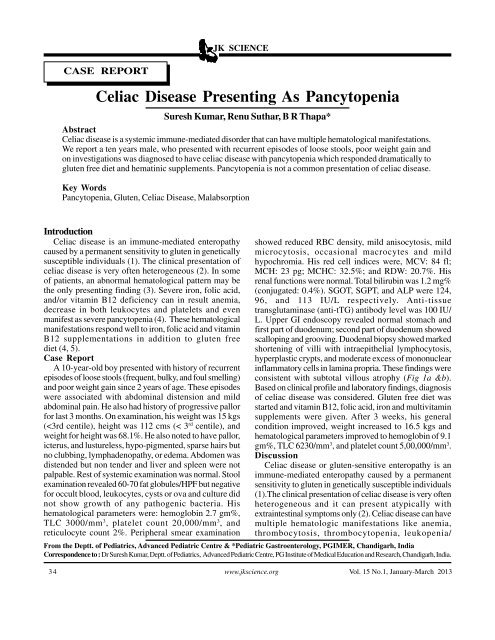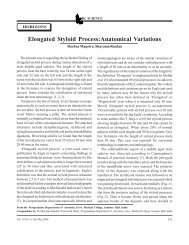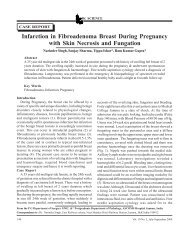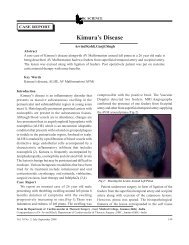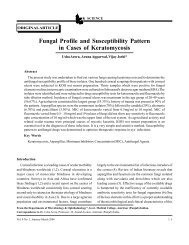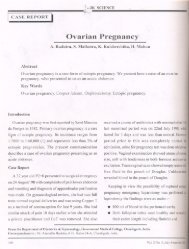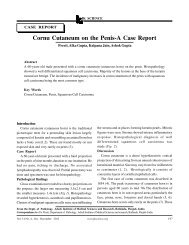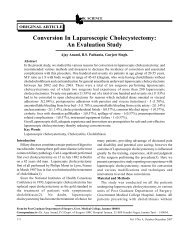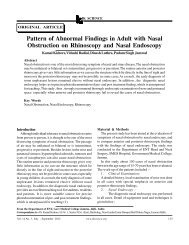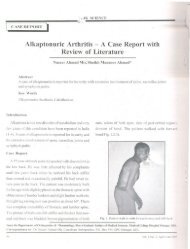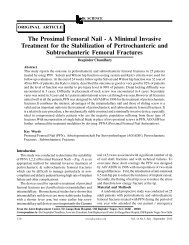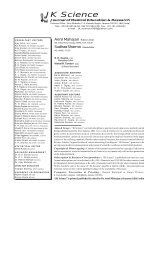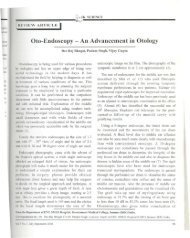34 Celiac disease presenting as pancytopenia - JK Science
34 Celiac disease presenting as pancytopenia - JK Science
34 Celiac disease presenting as pancytopenia - JK Science
You also want an ePaper? Increase the reach of your titles
YUMPU automatically turns print PDFs into web optimized ePapers that Google loves.
<strong>JK</strong> SCIENCECASE REPORT<strong>Celiac</strong> Dise<strong>as</strong>e Presenting As PancytopeniaSuresh Kumar, Renu Suthar, B R Thapa*Abstract<strong>Celiac</strong> <strong>dise<strong>as</strong>e</strong> is a systemic immune-mediated disorder that can have multiple hematological manifestations.We report a ten years male, who presented with recurrent episodes of loose stools, poor weight gain andon investigations w<strong>as</strong> diagnosed to have celiac <strong>dise<strong>as</strong>e</strong> with <strong>pancytopenia</strong> which responded dramatically togluten free diet and hematinic supplements. Pancytopenia is not a common presentation of celiac <strong>dise<strong>as</strong>e</strong>.Key WordsPancytopenia, Gluten, <strong>Celiac</strong> Dise<strong>as</strong>e, MalabsorptionIntroduction<strong>Celiac</strong> <strong>dise<strong>as</strong>e</strong> is an immune-mediated enteropathycaused by a permanent sensitivity to gluten in geneticallysusceptible individuals (1). The clinical presentation ofceliac <strong>dise<strong>as</strong>e</strong> is very often heterogeneous (2). In someof patients, an abnormal hematological pattern may bethe only <strong>presenting</strong> finding (3). Severe iron, folic acid,and/or vitamin B12 deficiency can in result anemia,decre<strong>as</strong>e in both leukocytes and platelets and evenmanifest <strong>as</strong> severe <strong>pancytopenia</strong> (4). These hematologicalmanifestations respond well to iron, folic acid and vitaminB12 supplementations in addition to gluten freediet (4, 5).C<strong>as</strong>e ReportA 10-year-old boy presented with history of recurrentepisodes of loose stools (frequent, bulky, and foul smelling)and poor weight gain since 2 years of age. These episodeswere <strong>as</strong>sociated with abdominal distension and mildabdominal pain. He also had history of progressive pallorfor l<strong>as</strong>t 3 months. On examination, his weight w<strong>as</strong> 15 kgs(
<strong>JK</strong> SCIENCEFig. 1a & b Biopsy2nd Part of Duodenum - Subtotal VillousAtrophy with Intraepithelial Lymphocytosis, Hyperpl<strong>as</strong>ticCrypts, & Moderate Excess of Mononuclear InflammatoryCells in Lamina Proprianeutropenia, venous thromboembolism, coagulopathy,hyposplenism, IgA deficiency, and lymphoma (4). Anemiais common complication of celiac <strong>dise<strong>as</strong>e</strong> (4). Theprevalence of anemia in celiac <strong>dise<strong>as</strong>e</strong> varies greatly andh<strong>as</strong> been found in 12% to 69% of newly diagnosedpatients with celiac <strong>dise<strong>as</strong>e</strong> (6, 7). Fisgin et al studied 22patients with celiac <strong>dise<strong>as</strong>e</strong> and found that anemia w<strong>as</strong>present alone in 19 (86.3%) patients, leukopenia coexistedwith anemia in 2 (9%) patients, and thrombocytopeniaalone w<strong>as</strong> found in 1 (4.5%) patient (8). There have beenonly -c<strong>as</strong>e reports of anemia with severethrombocytopenia (9), and <strong>pancytopenia</strong> (10) in celiac<strong>dise<strong>as</strong>e</strong>.Cause of <strong>pancytopenia</strong> in celiac <strong>dise<strong>as</strong>e</strong> ismultifactorial. Severe deficiency of Iron, folic acid, vitaminB12, and other nutrients can lead to <strong>pancytopenia</strong> (4).Deficiency of folic acid and vitamin B12 usually presents<strong>as</strong> macrocytic and megalobl<strong>as</strong>tic anemia, butabnormalities of the other cell lines are common. Severefolic acid and vitamin B12 deficiency can result in aleukopenia, thrombocytopenia and even manifest <strong>as</strong>severe <strong>pancytopenia</strong> (4). The pathogenesis of iron andother micronutrient deficiency in patients with celiac<strong>dise<strong>as</strong>e</strong> is likely to be due to decre<strong>as</strong>ed oral intake causedby reduced food intake due to anorexia and vomitingwhich are the common symptoms of celiac <strong>dise<strong>as</strong>e</strong>,malabsorption due to reduction in the absorptive surfaceor by an alteration of the small intestinal mucosa brushborder, and incre<strong>as</strong>ed losses within the small intestinedue to rapid enterocyte turnover resulting from the chronicinflammation (4, 11). Copper deficiency h<strong>as</strong> beendescribed in adults and children with celiac <strong>dise<strong>as</strong>e</strong> andmay result in anemia, leukopenia, and thrombocytopenia(8). Thrombocytopenia and leukopenia may be secondaryto autoimmune phenomenon (4). The diagnosis of celiac<strong>dise<strong>as</strong>e</strong> is usually made with the help of a small-bowelbiopsy, which is still considered the gold standard fordiagnosis (12). Various serological tests are used of whichanti-tTG antibodies are the most practical test and arenow widely used for diagnosing celiac <strong>dise<strong>as</strong>e</strong> (4). Thetreatment of celiac <strong>dise<strong>as</strong>e</strong> is primarily gluten free diet.Hematological manifestations respond to ironsupplementation, folic acid, and parenteral vitamin B12(4). Iron should be given until the iron stores have beenrestored. This process can take <strong>as</strong> long <strong>as</strong> a year for thehemoglobin to normalize and 2 years for the iron storesto be replete. In these patients, the full recovery of thesmall intestinal mucosa following the introduction of agluten-free diet, allows the hematological parameters tobecome normal (5).The cause of <strong>pancytopenia</strong> in indexpatient is probably multifactorial. Proper history,examination and targeted investigations lead to diagnosisof celiac <strong>dise<strong>as</strong>e</strong>; dietary management and hematinicsresulted in expected recovery.ConclusionPancytopenia is an uncommon hematologicalcomplication in celiac <strong>dise<strong>as</strong>e</strong>. Severe deficiencies of iron,folate, vitamin B12& micronutrients can lead to<strong>pancytopenia</strong> which responds dramatically to gluten freediet and supplementations with micronutrients. <strong>Celiac</strong><strong>dise<strong>as</strong>e</strong> must be considered, if changes in hematologicalparameters occur in <strong>as</strong>sociation with GI symptoms.References1. Hill ID, Dirks MH, Liptak GS, et al. Guideline for thediagnosis and treatment of celiac <strong>dise<strong>as</strong>e</strong> in children:recommendations of the North American Society forPediatric G<strong>as</strong>troenterology, Hepatology and Nutrition. JPediatr G<strong>as</strong>troenterol Nutr 2005; 40: 1-19.2. Rodrigo L. <strong>Celiac</strong> <strong>dise<strong>as</strong>e</strong>. World J G<strong>as</strong>troenterol. 2006; 12:6585-93.3. Economou M, Karyda S, Gombakis N, et al. Subclinicalceliac <strong>dise<strong>as</strong>e</strong> in children: refractory iron deficiency <strong>as</strong> thesole presentation. J Pediatr Hematol Oncol 2004; 26: 153-4.4. Halfdanarson TR, Litzow MR, Murray JA. Hematologicmanifestations of celiac <strong>dise<strong>as</strong>e</strong>. Blood 2007; 109: 412-21.5. Annibale B, Severi C, Chistolini A, et al.Efficacy of glutenfreediet alone on recovery from iron deficiency anemia inadult celiac patients. Am J G<strong>as</strong>troenterol 2001; 96: 132-376. Bottaro G, Cataldo F, Rotolo N, et al. The clinical patternof subclinical/silent celiac <strong>dise<strong>as</strong>e</strong>: an analysis on 1026consecutive c<strong>as</strong>es. Am J G<strong>as</strong>troenterol 1999; 94: 691-967. Lo W, Sano K, Lebwohl B, et al. Changing presentation ofadult celiac <strong>dise<strong>as</strong>e</strong>. Dig Dis Sci 2003; 48: 395-988. Fisgin T, Yarali N, Duru F, Usta B, Kara A. Hematologicmanifestation of childhood celiac <strong>dise<strong>as</strong>e</strong>. Acta Haematol2004; 111: 211-14.9. Hatting M, Galm O, Meyer M, et al. Anemia and severethrombocytopenia in celiac <strong>dise<strong>as</strong>e</strong>. Med Klin (Munich)2010; 105: 249-52.10. Albayrak F, Dursun H, Yildirim R, et al. A c<strong>as</strong>e of atypicalceliac hepatitis <strong>presenting</strong> with hypogonadism,<strong>pancytopenia</strong> and lymphadenopathy. Turk J G<strong>as</strong>troenterol2011; 22: 226-28.11. Sabel'nikova EA, Parfenov AI, Krums LM, Gudkova RB.<strong>Celiac</strong> <strong>dise<strong>as</strong>e</strong> <strong>as</strong> a cause of iron deficiency anemia. TerArkh 2006; 78: 45-8.12. Jones RB, Robins GG, Howdle PD. Advances in celiac<strong>dise<strong>as</strong>e</strong>. Curr Opin G<strong>as</strong>troenterol 2006; 22: 117-23.Vol. 15 No. 1, January-March 2013 www.jkscience.org 35


